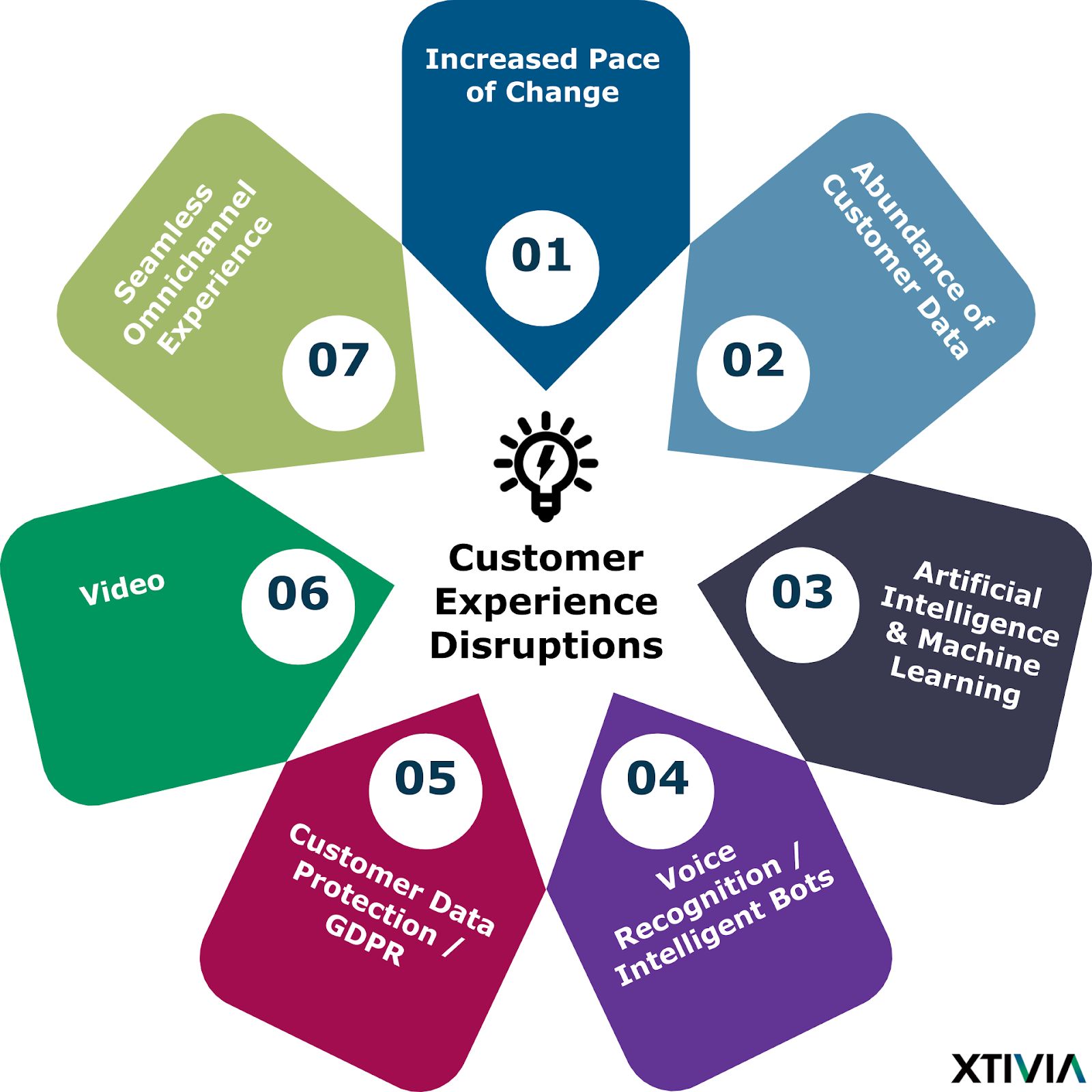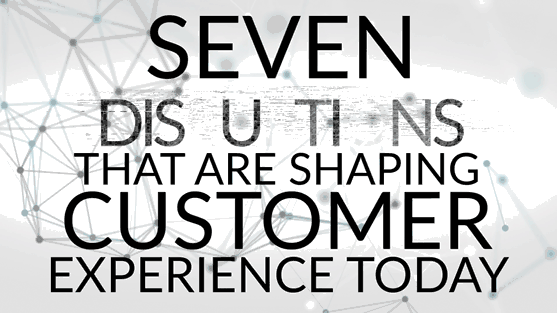A shorter version of this post was originally published on Forbes.com. You can read the original version or this post which provides more context around each of the disruptions.
Today’s rapid pace of disruptive change is shaping customer expectations and, therefore, Customer Experience (CX) in ways that threaten to leave less agile brands behind.
Offering the right products in the right place at the right time is a given for success today — and it’s not enough. Instead, it’s about what your customer expects from your brand as their individual experience, at any time, from anywhere and via any device. The value of your customer relationships is expressed through personalized one-on-one experiences, responsive customer service and connected experiences across channels.
What’s more, customers are judging brands against their most recent stellar customer experience; that means industry disrupters like Amazon, Airbnb and Uber are the standards against which your brand is measured. Your CX must be on par or your business future could be in question.
According to Gartner:
“Customer Experience is at the top of every business’ priority list. It concerns the CEO to the CMO and even the CIO. Emerging technology, changing consumer needs and effective use of customer data are critical elements to ensuring your Customer Experience Strategy is as powerful as possible in a competitive and digital landscape.”
In this article, we’ll look at 7 disruptions that have contributed to and are shaping Customer Experience and Customer Experience strategies today.
1. The increased pace of change.
Technological advances are unfolding at a vastly accelerated pace and it seems that not a day goes by without the next groundbreaking development emerging. What was groundbreaking yesterday is yesterday’s news today – I am being facetious but the reality is that the half-life of technology seems to shrink every year.
The challenge in all this from a Customer Experience perspective is to identify what is useful, relevant and desirable. The big wins being realized from this disruption happen when technology is humanized and made relevant to real people.
2. Abundance of customer data.
These days, brands are collecting vast amounts of data about customers, their interactions, buying preferences and behaviors, and more. Essentially, data can be collected in three ways:
- By asking customers for it directly (via profiles and preferences).
- By indirectly tracking customers (via interaction analytics).
- By connecting other data sources to our own (via third-party data providers such as Data.com, Zoominfo, and others).
Data collection on this scale, and the manipulation of the data collected represents a huge opportunity for the savvy disruptors to gain a competitive advantage and secure big wins over the competition.
Bear in mind, however, that in order to get the most from big data’s potential, it’s necessary to “translate” the information into actionable strategies that companies can use to grow sales, increase profitability and enhance Customer Experience. “Actionable” is key. If your translation is too complicated or doesn’t clearly demonstrate value, there’s a real danger it will be ignored.
3. Artificial intelligence (AI) and machine learning (ML).
Most applications of AI for business lie in the AI subset of machine learning. Programmers have designed clever algorithms that can “learn” from previous results and shape outputs based on that accumulated knowledge. These capabilities are being leveraged today to detect patterns in customer data, behavior and needs which, in turn, enable enhanced customer experiences through hyper-personalization and responsive customer service.
As examples, Spotify uses AI to predict what music you’d most like to hear, Domino’s Pizza’s customers can order using the Facebook messenger chatbot and Kentucky Fried Chicken (KFC) is partnering with Chinese search engine, Baidu, to develop a restaurant that can anticipate your order and make recommendations using face recognition technology.
However, AI still has a long way to go and a massive amount of disruption is still lurking somewhere down the road. If you consider machine learning as functioning on a single layer between input and output, deep learning (the future) will function across complicated cross-functional networks, multiplying its output capabilities exponentially.
4. Voice recognition and intelligent bots.
Advances in machine learning are also behind performance improvements in virtual reality (VR) systems, such as Apple’s virtual assistant Siri. Interestingly, in research conducted in 2016, Siri was found to have an IQ of 23.94, well below that of an average 6-year-old. It’s useful to think of Siri as a “programmed robot” rather than having true AI and the ability to creatively solve problems.
A major payoff from advances in machine learning (and potentially AI) from a Customer Experience perspective lies with intelligent bots that can actually interact with users.
Contrast the current Customer Experience of a typical call center user – select an option from 1-5, select another option from 1-5 (maybe even a third time), hold and eventually get through to an operator, go through a security check, eventually be transferred to someone with the knowledge to help you – with a bot that security checks you against your voice using voice recognition, has immediate access to all your data, engages you in conversation before handing you over to the most experienced agent for your particular query.
5. Customer data protection and the GDPR (General Data Protection Regulation).
Along with the ability to compile, slice and dice, and exploit vast amounts of data comes certain responsibilities and, understandably in view of the rapid pace of change, legislation is still chasing the curve.
You need look no further than the data breach announced by Equifax in September of 2017 to understand the dire consequences of getting it wrong. Equifax revealed that the data of 143 million users had been compromised by hackers. The cause? Equifax failed to apply a simple software patch to their Apache Struts web application.
The fallout for Equifax has been bruising. Customers have filed lawsuits, the company’s competence to process and store customer data is under scrutiny, and their efforts at damage limitation have been lambasted as a cover-up.
But, here’s the thing. Much of the data held by Equifax is not as the result of customers choosing to do business directly with them. They hold commercial data that’s used to perform credit checks on anyone living or working in the U.S., and that’s a twist that represents a challenge for legislators looking to protect consumers.
The GDPR is the European Union’s (EU’s) data legislation initiative primarily aimed at protecting the privacy of European citizens’ personal data. However, user data is stored globally on many devices as well as in the cloud, so the GDPR has implications worldwide for companies who store PII (Personally Identifiable Information). The GDPR is also a good indicator of the kind of legislation we can expect in the future.
From a GDPR and customer experience perspective, you need to have systems in place that allow customers to see what data you’re tracking about them, give them the option to opt out of being tracked, AND your systems need to be nimble enough to cope should a customer request their data to be deleted.
6. Video.
While you might consider video as being yesterday’s disruptor, it deserves a special mention because not only has it turned the way we consume information on its head, there are serious downsides to not engaging with video.
A good example is how video relates to your business website – if you’re looking to get found in organic search that is. One of the metrics Google uses to determine the relevance of your website or web page is “dwell time”, which is how long a user spends on page. Video greatly enhances this metric.
Brands today can leverage video in old and new ways to enhance customer experience – old, but still good, as in step-by-step instructions on how to use your product or new as in a virtual reality video that allows you to test drive a car when you can’t go to a dealership.
7. The seamless omni-channel experience.
Regardless of whether you use Salesforce to manage customer support, SAP to manage orders and Riversand (Product Information Management or PIM software) to manage product information, your customers expect a seamless and unified customer experience that doesn’t require them to hop across systems/applications to do what they need to do. This implies integration across your enterprise.
This holds true regardless of how your customers choose to interact with your brand, be it via the web, a mobile device, social media, IVR, a call center, chat or any other available channel. A seamless omni-channel experience, with a strong and relevant brand presence at each stage of your customer’s journey, is key to delivering a superior customer experience, encouraging brand loyalty and maximizing customer satisfaction.
Putting it Together

The 7 Customer Experience Disruptions
A seamless Customer Experience spells opportunity for your business
It’s clear there’s a serious upside for organizations that understand and embrace the disruptions discussed in this article. And this is true for just about all organizations; even organizations in industries that are not traditionally considered to be forward-thinking. As an example, Spire, a gas utility serving 1.7 million customers across Missouri, Mississippi and, Alabama, is breaking the mold by reducing friction in all aspects of its business and providing a seamless Customer Experience across several channels such as web, mobile, IVR, call center, Alexa, and more.
While the increasing pace of advances in technology threatens to leave less agile brands struggling behind the curve, intelligent use of customer data and digital experience platforms represent a serious opportunity for savvy businesses to outperform their competitors.
Your potential and current customers have more choice of who to trust with their business than ever before and customer experience is a huge part of their decision-making.
At XTIVIA, we clearly understand the importance of delivering the seamless, omni-channel customer experience your customers demand. Talk to a trusted advisor at XTIVIA today to get started transforming your customer experience and customer journey with strategy, design and implementation services from XTIVIA.

